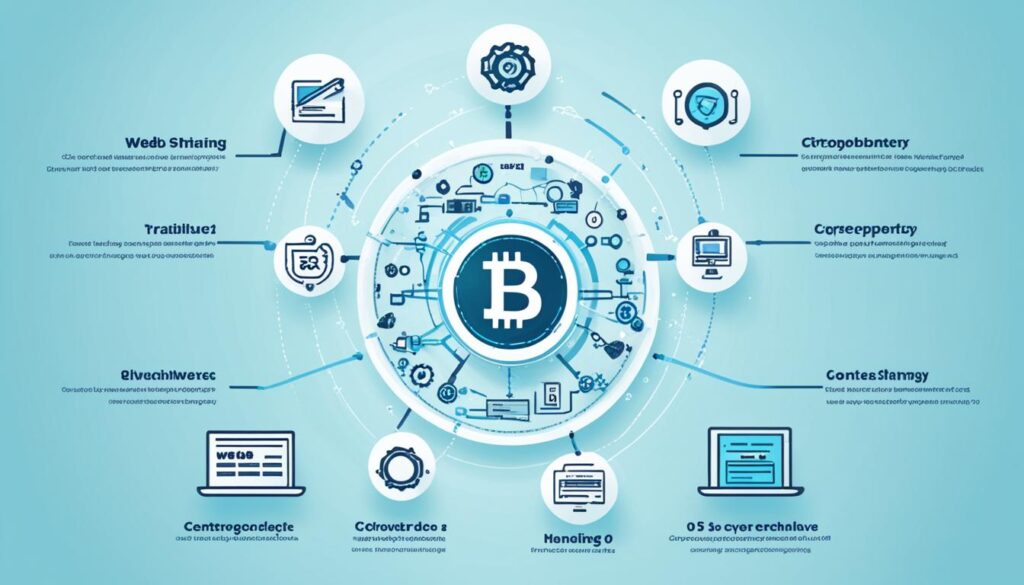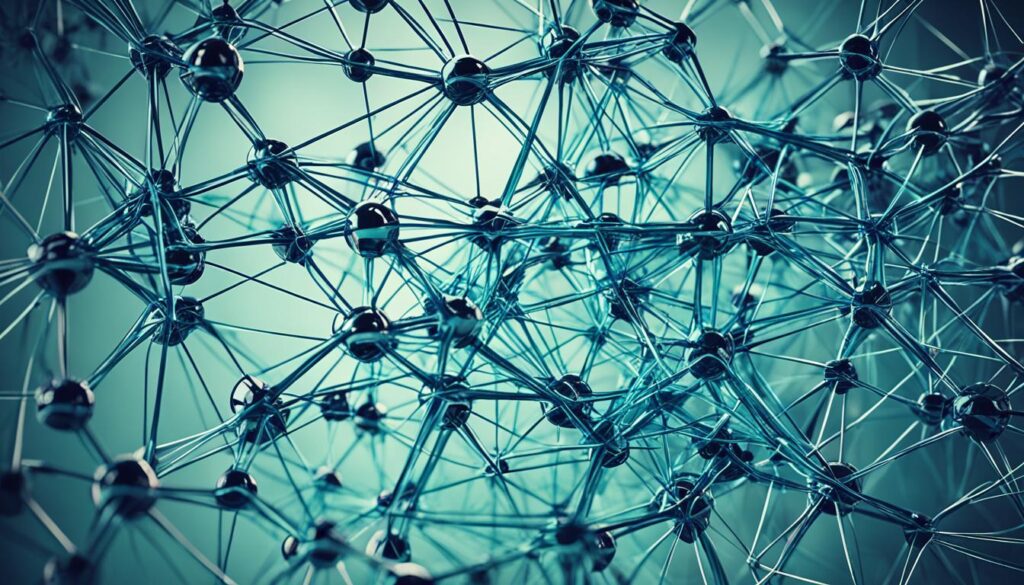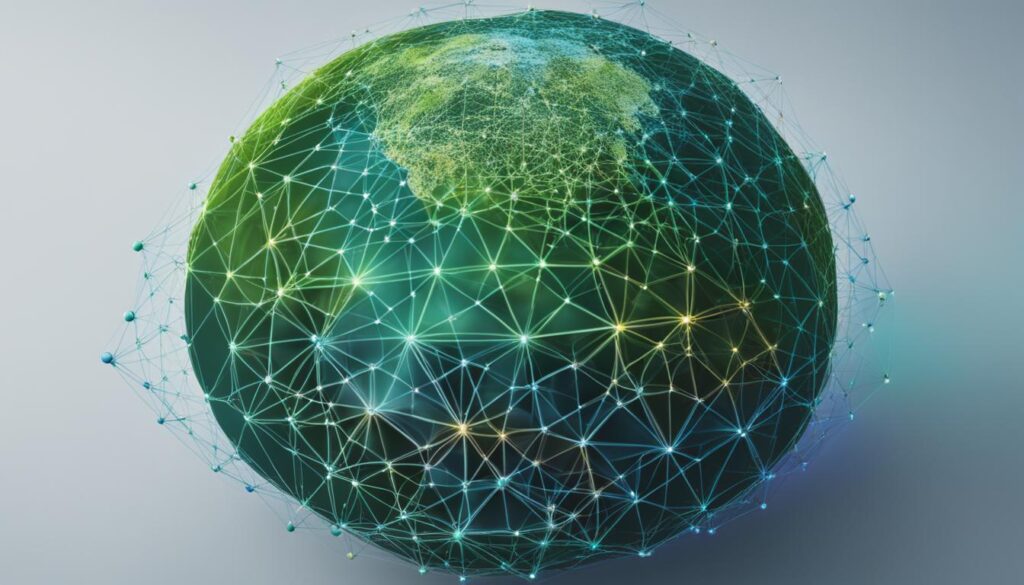Welcome to the era of Web 3.0, where the digital landscape is undergoing a transformative shift. Web 3.0, also known as Web3, is revolutionizing the way we interact with the internet, creating new models for decentralized social impact. With its focus on decentralization and user empowerment, Web 3.0 is paving the way for innovation and community-led solutions that have a lasting positive effect on society.
Unlike its predecessors, Web 3.0 gives users more control over their personal data and introduces features like cryptocurrencies and blockchain technology. With a decentralized approach, Web 3.0 challenges the traditional model of centralized platforms and aims to empower individuals and communities, fostering a more inclusive and collaborative digital environment.
Through its distributed architecture and innovative technologies, Web 3.0 is creating opportunities for decentralized social impact. It enables individuals to participate in networks that prioritize community-led solutions, fostering innovation and addressing social challenges at scale. With increased transparency, ownership, and trust, Web 3.0 opens up avenues for positive change.
Join us as we delve into the world of Web 3.0 and explore how it is shaping the future of decentralized social impact. Discover the potential and pitfalls, the key features that define Web 3.0, and the psychological implications for users. Let’s navigate this new era together, empowered by the possibilities and aware of the responsibilities that Web 3.0 brings.
Key Takeaways:
- Web 3.0 is revolutionizing the internet by shifting towards decentralization and empowering users.
- Decentralized social impact models are being developed, fostering innovation and community-led solutions.
- Web 3.0’s key features include decentralization, trustlessness, artificial intelligence, and enhanced connectivity.
- Potential benefits of Web 3.0 include increased user control, community empowerment, and new models for social impact.
- Pitfalls to consider include legal challenges, privacy concerns, and the need for responsible engagement.
The Evolution of the Web: From 1.0 to 3.0
The internet has undergone significant transformations throughout its history, moving from static webpages to dynamic and decentralized platforms. This evolution can be categorized into different versions, each bringing new capabilities and opportunities for users. Let’s explore the journey from Web 1.0 to Web 3.0.
Web 1.0: The Beginning of the Internet
“The Web as I envisaged it, we have not seen it yet. The future is still so much bigger than the past.” – Tim Berners-Lee
In the early days, the internet was characterized by Web 1.0, also known as the “read-only web.” This version featured static webpages where users could only consume information but had limited interaction. It was primarily a one-way communication channel, where websites provided content and users passively absorbed it. The emphasis was on delivering information rather than fostering user participation.
Web 2.0: Empowering User Participation
With the advent of Web 2.0, the internet underwent a transformative shift. Web 2.0 introduced interactivity, social connectivity, and user-generated content, enabling a more dynamic and participatory web experience. Websites became platforms for collaboration and user engagement, giving rise to social media, blogging platforms, and online communities.
- Interactive content: Web 2.0 introduced features like embedded videos, interactive forms, and multimedia elements, enhancing the overall user experience.
- Social connectivity: Networking platforms like Facebook and Twitter enabled users to connect and interact with others, fostering a sense of community and online socialization.
- User-generated content: Blogs, wikis, and other platforms allowed users to create and publish their own content, democratizing the flow of information.
Web 3.0: Emphasizing Decentralization and User Control
Web 3.0 represents the next evolution of the internet, emphasizing decentralization, privacy, and user control. It builds upon the features of Web 2.0 and introduces innovative technologies like blockchain and artificial intelligence.
“Web 3.0 will be about connecting truly peer-to-peer, creating decentralized networks and ecosystems.” – Andreas Antonopoulos
Decentralization is a key aspect of Web 3.0, enabling data to be stored and accessed in multiple locations simultaneously, reducing reliance on centralized entities. With Web 3.0, users have greater control over their personal data, fostering privacy and increased security. Additionally, the integration of blockchain technology allows for transparency, trustlessness, and the development of decentralized applications (DApps).
Artificial intelligence also plays a significant role in Web 3.0, enhancing automation and personalization. Intelligent algorithms and machine learning algorithms analyze vast amounts of data to provide customized experiences, transforming how we interact with information and services online.
Image:

| Web Version | Features |
|---|---|
| Web 1.0 | Static webpages, limited user interaction |
| Web 2.0 | Interactive content, social connectivity, user-generated content |
| Web 3.0 | Decentralization, user control, blockchain, artificial intelligence |
Key Features of Web 3.0
Web 3.0 is ushering in a new era of internet technology, revolutionizing the way we interact with the digital world. This next generation web is characterized by several key features, all geared towards enhancing user control, privacy, and connectivity.
Decentralization
At the heart of Web 3.0 lies decentralization. Unlike Web 2.0, which relied heavily on centralized platforms and entities, Web 3.0 embraces a distributed architecture. This allows data to be stored and accessed in multiple locations simultaneously, reducing reliance on intermediaries and giving users more control over their personal information.
Trustlessness
Trustlessness is another crucial aspect of Web 3.0. By leveraging blockchain technology, web interactions can be secured and validated without the need for trust in a centralized authority. Smart contracts and cryptographic mechanisms ensure the integrity of transactions and data exchanges, empowering users to engage directly with each other in a trustless environment.
Artificial Intelligence
Artificial intelligence (AI) plays a prominent role in the evolution of the web. With Web 3.0, AI and machine learning capabilities are integrated into various aspects of online experiences. This enables advanced automation, personalized recommendations, and intelligent decision-making processes, enhancing user engagement and efficiency.
Connectivity
Web 3.0 aims to seamlessly integrate with everyday devices and enhance connectivity. The internet becomes ubiquitous, allowing users to access information and services anytime, anywhere. The Internet of Things (IoT) further amplifies connectivity, creating a network of interconnected devices that can interact and exchange data in real-time.
This table summarizes the key features of Web 3.0:
| Feature | Description |
|---|---|
| Decentralization | Allows data to be stored and accessed in multiple locations simultaneously. |
| Trustlessness | Enables direct interaction without the need for intermediaries. |
| Artificial Intelligence | Enhances automation, personalization, and decision-making processes. |
| Connectivity | Ensures seamless access to information and integration with everyday devices. |

The Potential and Pitfalls of Web 3.0
Web 3.0 has the potential to revolutionize various aspects of society. It brings forth new opportunities for greater user utility and control over personal data, paving the way for decentralized networks and social impact models.
With Web 3.0, communities are empowered to create new models for driving social impact, fostering innovation, and addressing pressing societal challenges. By leveraging decentralized technologies, individuals can participate directly in decision-making processes, enhancing inclusivity and democratizing solutions.
However, alongside its potential lies a set of potential pitfalls that must be considered. Decentralization introduces legal and regulatory challenges that need to be carefully navigated. Issues surrounding privacy, cybersecurity, and misinformation require robust frameworks to safeguard users in this evolving landscape.
Addressing these pitfalls is crucial to ensure the responsible and sustainable implementation of Web 3.0. It requires proactive efforts from regulators, businesses, and users to strike a balance between leveraging the power of decentralized technologies and mitigating associated risks.
The decentralized nature of Web 3.0 empowers communities to drive social impact and foster innovation.
Key considerations for the successful adoption of Web 3.0 include:
- Developing legal and regulatory frameworks that facilitate innovation and protect user rights
- Establishing robust security protocols to safeguard user data and mitigate cybersecurity threats
- Enhancing digital literacy to address misinformation and promote responsible engagement
- Fostering collaboration between stakeholders to ensure inclusive governance and decision-making processes
By addressing these challenges and embracing the potential of Web 3.0, we can create a more equitable and resilient digital future.
The Pitfalls of Web 3.0
While the potential of Web 3.0 is vast, it is essential to acknowledge and mitigate the associated pitfalls. Some of these pitfalls include:
- Fragmentation: The decentralized nature of Web 3.0 can lead to fragmentation, making it challenging to establish interoperability and seamless experiences across different platforms.
- Trust and Transparency: Decentralization can challenge traditional notions of trust and transparency, as users rely on cryptographic mechanisms rather than centralized authorities. Striking a balance between privacy and transparency becomes crucial.
- Scalability: As Web 3.0 evolves, scalability becomes a critical concern. Ensuring that decentralized networks can handle increasing demand while maintaining efficiency and usability is a challenge that needs to be addressed.
These pitfalls highlight the need for ongoing research, collaboration, and innovation to overcome obstacles and unlock the full potential of Web 3.0.

Next, we will explore the psychological implications of Web 3.0 and how it reshapes our trust, ownership, and sense of community.
Web 3.0 and the Psychological Implications
Web 3.0 and blockchain technology have profound psychological implications for users, influencing our perception of trust, ownership, transparency, and community.
Redefining Trust
In the era of Web 3.0, trust is redefined as users shift their reliance from centralized authorities to cryptographic mechanisms. Blockchain technology introduces a new level of trust, as transactions are securely recorded and verified. The decentralized nature of Web 3.0 fosters trustworthiness by removing the need for intermediaries and introducing transparency into transactions.
Empowering Ownership
One of the key psychological impacts of Web 3.0 is the concept of ownership. Users have greater control over their digital assets and personal data, empowering them with a sense of ownership and autonomy. This ownership extends to decentralized finance, where users have ownership over their financial activities without the need for traditional institutions.
Unveiling Transparency
Transparency is a double-edged sword in the world of Web 3.0. While the transparency of blockchain technology enhances trustworthiness, it also raises concerns about privacy. The public nature of blockchain transactions means that personal information, once recorded, becomes part of an immutable ledger. Finding the right balance between transparency and privacy is crucial for navigating this new paradigm.
Fostering Community
Web 3.0 brings the power of decentralized communities, where individuals can come together based on shared interests and values. These communities foster a sense of belonging, enabling collaboration and innovation. However, it’s essential to be mindful of the potential for echo chambers and tribalism within these communities. Striving for diversity of thought and welcoming different perspectives is key to maintaining a healthy decentralized community.
| Psychological Impact | Areas of Impact |
|---|---|
| Trust | Redefinition of trust in a decentralized environment |
| Ownership | Empowering individuals with ownership of digital assets and data |
| Transparency | Unveiling the balance between transparency and privacy |
| Community | Fostering decentralized communities and addressing potential pitfalls |
Understanding the psychological impact of Web 3.0 is crucial for individuals and communities as we navigate this decentralized future. The redefined trust, ownership, transparency, and community dynamics shape our interactions and experiences in this new era of the internet.

Conclusion
Web 3.0 marks a transformative era in the digital landscape, ushering in decentralization and innovation with profound implications for society. This new generation of the web has the potential to create new models for decentralized social impact, enabling individuals to take control of their data and participate in community-led solutions. However, as we embrace the opportunities that Web 3.0 offers, we must also address the challenges that arise.
Legal and regulatory risks pose a significant obstacle to the widespread adoption of Web 3.0. As decentralized networks emerge, governing bodies must establish frameworks that protect users’ rights without stifling innovation. Privacy concerns also loom large, with individuals seeking greater control over their personal information while ensuring transparency and accountability.
Responsible engagement becomes paramount in this new digital landscape. As Web 3.0 empowers individuals, we must navigate the balance between empowerment and the well-being of society as a whole. Understanding the psychological implications of this decentralized future is crucial to foster trust, ownership, and community while avoiding the pitfalls of echo chambers and tribalism.
Web 3.0’s impact reaches far and wide, shaping the aspirations of a new era across industries and societies. By embracing the potential, addressing the challenges, and fostering responsible engagement, we can harness the true power and realize the transformative impact of Web 3.0 for the betterment of individuals and communities alike.
FAQ
What is Web 3.0?
Web 3.0, also known as Web3, is the third generation of the World Wide Web (WWW) that emphasizes decentralization and user control. It introduces features like cryptocurrencies and blockchain technology.
How does Web 3.0 differ from previous versions?
Web 3.0 builds upon the features of Web 2.0 and introduces innovations like blockchain and artificial intelligence. It emphasizes decentralization, giving users more control over their personal data and fostering community-led solutions.
What are the key features of Web 3.0?
Web 3.0 is characterized by decentralization, trustlessness, artificial intelligence, and connectivity. It allows data to be stored and accessed in multiple locations, enables direct interaction without intermediaries, enhances automation and personalized experiences with AI, and ensures seamless access to information.
What is the potential impact of Web 3.0?
Web 3.0 has the potential to create new models for decentralized social impact, empowering individuals, fostering innovation, and enabling community-led solutions.
What are the potential pitfalls of Web 3.0?
Decentralization brings legal and regulatory challenges, and there are concerns about privacy, cybersecurity, and misinformation that need to be addressed in this new paradigm.
What are the psychological implications of Web 3.0?
Web 3.0 redefines trust as users shift their reliance from centralized authorities to cryptographic mechanisms. It empowers individuals with ownership of digital assets and data, enhances transparency through blockchain, and provides a sense of belonging in decentralized communities.








